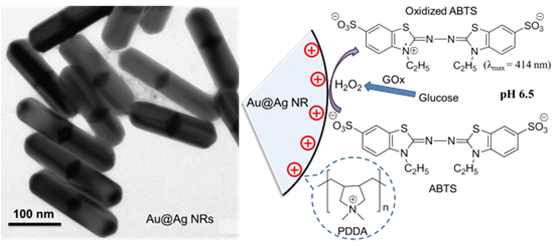Cost-effective Nanozyme with Excellent Peroxidase-like Activity
Natural peroxidases are of great practical significance in the fields of catalytic industry, pharmaceuticals, biosensor, food safety, environmental protection and genetic breeding. However, natural peroxidases as proteins suffer some disadvantages such as cockamamie steps for isolation and purification, as well as denaturation in complex conditions. As the efficient peroxidase alternatives, nanomaterial-based enzyme mimetics (nanozymes) have many unique properties including high stability, low cost, large surface-to-volume ratio and high catalytic activity. However, to date, most of the reported peroxidase mimetics need to work in acidic conditions (pH < 5.0) rather than nearly neutral conditions (pH 6.0-7.4), which would limit their practical applications.
Recently, Prof. LIU Aihua and his team from the Biosensing Group, Qingdao Institute of Bioenergy and Bioprocess Technology (QIBEBT), Chinese Academy of Sciences, developed Au@Ag heterogeneous nanorods (NRs) (Au@Ag NRs) synergistic peroxidase-like interfaces (nanozyme) at nearly neutral pH. The nanozyme is cost-effective because Ag accounts for over 90% in the bimetallic nanostructure. The work is published online in ACS Applied Materials & Interfaces. The proposed nanozyme could become promising substitute for peroxidase in pharmaceutical industry, food industry, analytical chemistry, industrial catalyst and environmental science. This research will also provide a strategy of developing the next generation of nanozyme system.
Mr. HAN Lei from the team discovered that the catalytic activity of nanozyme can be regulated by modulating the nano-structure, composition, surface property of the bimetallic materials, substrates and pH value of the reaction solution. The positively charged Au@Ag NRs exhibit high activity to catalyze hydrogen peroxide (H2O2) over a wide pH range (pH 4.0-6.5) using 2′-azino-bis(3-ethylbenzthiazoline-6-sulfonic acid) diammonium salt (ABTS) as the chromogenic substrate (Figure 1), while Au nanoparticles (NPs) and Ag NPs only show activity in acidic conditions (pH 3.5-4.5). Moreover, the Au@Ag NRs show excellent temperature stability and long-term storage stability. Considering that the nanozyme and glucose oxidase (GOx) have similar optimal pH for catalytic activities, a novel one-pot method for the colorimetric detection of glucose is further developed by the coupled catalytic reaction using GOx, Au@Ag NRs and ABTS at nearly neutral pH (pH 6.5) (Figure 2). This proposed method shows prominent advantages of low cost, wide linear range, high sensitivity and reliability for the successful analysis of glucose in real samples, which avoids the multi-step operation of conventional colorimetric methods.
This work is financially supported by National Natural Science Foundation of China.
 |
| Figure 1.The optical absorption spectra of different systems. (a) ABTS + H2O2+ Au@Ag NRs;(b) ABTS + H2O2;(c) Au@Ag NRs. (Image by QIBEBT) |
 |
| Figure 2.The one-pot method for the detection of glucose by using Au@Ag heterogeneous NRs and GOx. (Image by QIBEBT) |
Reference:
Au@Ag Heterogeneous Nanorods as Nanozyme Interfaces with Peroxidase-like Activity and Their Application for One-Pot Analysis of Glucose at Nearly Neutral pH, ACS Applied Materials & Interfaces, 2015,10.1021/acsami.5b03591.
Contact: Prof. LIU Aihua
Qingdao Institute of Bioenergy and Bioprocess Technology, Chinese Academy of Sciences
Email: liuah@qibebt.ac.cn